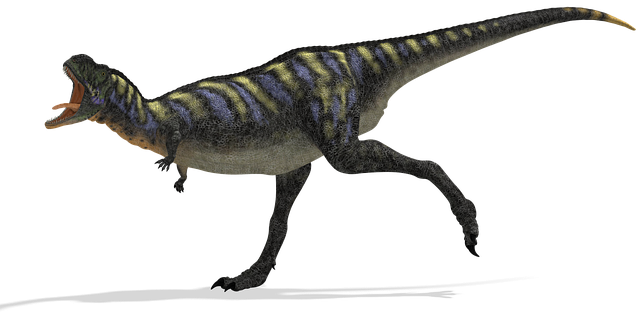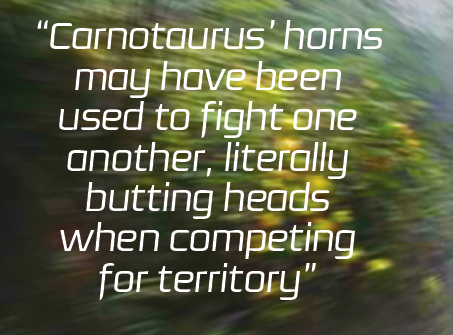Meet the Carnotaurus: the dinosaur with tiny arms

Meet the Carnotaurus: one of the weirdest dinosaurs to have walked the Earth
The Carnotaurus was one of the Late Cretaceous period’s most feared predators. It once stalked across the land with its bright, beady eyes, box-shaped head and distinctive bull-like horns. Standing around four metres tall and nine metres long, these unusual-looking giant theropods were the distant South American cousins of the T-rex. The Carnotaurus’ most distinctive feature, however, is its comical – and probably useless – tiny arms. These wouldn’t have made it any less ferocious if you were confronted with one. However, they do pose an evolutionary puzzle for palaeontologists today (see boxout opposite).
What do we know about the Carnotaur?
Only one Carnotaurus fossil has ever been discovered, unearthed in Argentina by palaeontologist Jose Bonaparte in 1985. However, it is almost a full skeleton and impressively detailed – including fossilised impre ssions of its skin in the surrounding Earth – making it a very rare find indeed. The remains have given palaeontologists a remarkable insight into the Carnotaurus’ anatomy, posture, habitat and diet. It’s not hard to see why palaeontologists chose the name Carnotaurus, meaning ‘meat-eating bull’. Its distinctive horns are thought to have been used by males to fight one another. The dinosaurs would have literally butted heads when competing for territory or to impress females.
ssions of its skin in the surrounding Earth – making it a very rare find indeed. The remains have given palaeontologists a remarkable insight into the Carnotaurus’ anatomy, posture, habitat and diet. It’s not hard to see why palaeontologists chose the name Carnotaurus, meaning ‘meat-eating bull’. Its distinctive horns are thought to have been used by males to fight one another. The dinosaurs would have literally butted heads when competing for territory or to impress females.
Like many other large theropods, Carnotaurus were carnivores and so had the sharp teeth to match. If their terrifying backwards-curving, flesh-tearing teeth were not enough to scare you, researchers suspect that the crafty Carnotaurus was also one of the most intelligent theropods – it could definitely outrun you, and it may have even been able to outsmart you.
Roarsome sprinter
Carnotaurus was a champion sprinter, capable of reaching speeds of 40 kilometres per hour. Two of the most striking pieces of evidence for this come from analysing the leg and tail of the fossil specimen. Its thigh bones were adapted to withstand bending movements when running, while bulky muscles in its tail also provided power. The caudofemoralis (a pair of muscles that ran either side of the tail) attached to a prominent ridge on the thigh bone to pull the leg backwards when contracted. The muscles were anchored to the tail bones, which, in the case of the Carnotaurus, were not T-shaped like slower-moving animals but instead formed a V-shape. This adaptation created more space for bigger caudofemoralis muscles, which made up some 15 per cent of the Carnotaurus’ entire body mass – larger than any other therapod. Because of this super sprinting ability, it’s thought that Carnotaurus would have been ambush predators, employing bursts of speed to catch their prey.
So why the small arms?
One of the first things that you’ll notice about the ferocious Carnotaurus is its disproportionately tiny arms. They’re so small that they’re little more than wrists. And if you’re thinking they look too tiny to be useful, you’re probably right. Though the radius and ulna bones that make up the lower arm are actually stronger and more robust than expected, their hands were certainly weak, particularly when you consider the strength of the rest of its titanic body.
However, the presence of the four fingers on their hands suggests that their arms must have either had some evolutionary purpose – or perhaps they had only recently become so ridiculously small and useless. Regardless of their unknown purpose (it has been hypothesised that perhaps the juvenile Carnotaurus were better proportioned and the arms only became useless in adulthood) the trend of smaller arms in carnivorous dinosaurs of the Cretaceous is well documented. The strong and powerful arms of Jurassic dinosaurs become mostly weak and useless in the Cretaceous, though there is little evidence suggesting why.
This article was originally published in How It Works issue 117, written by Charlie Evans
For more science and technology articles, pick up the latest copy of How It Works from all good retailers or from our website now. If you have a tablet or smartphone, you can also download the digital version onto your iOS or Android device. To make sure you never miss an issue of How It Works magazine, subscribe today!





